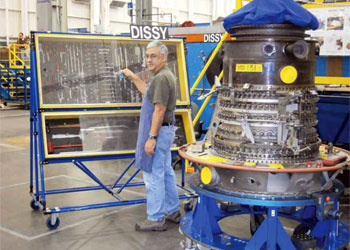
Keeping Up With The Tools
Integrated, scalable system controls and manages keys to locked tool boxes
- By Del V. Salvi
- Apr 01, 2012
There are hundreds of specialized tools used on a daily basis at the United Airlines jet engine rebuild and test facility, a 20-acre maintenance and operations center adjacent to San Francisco International Airport. United jets are brought to the facility, where more than 1,400 employees work, to have their engines rebuilt. Here a tool used every day might cost several thousand dollars, and test equipment can cost even more.
 Before a system was in place to keep up with these tools, they were not well organized and difficult to track. At times tools could be lost or misplaced, at a possible cost of $10,000 to $20,000, remembers Bob Brown, senior specialist for continuous improvement at the United jet shop.
Before a system was in place to keep up with these tools, they were not well organized and difficult to track. At times tools could be lost or misplaced, at a possible cost of $10,000 to $20,000, remembers Bob Brown, senior specialist for continuous improvement at the United jet shop.
Brown and the continuous improvement team were tasked with solving the problem of lost tools. First, they transitioned the facility to “point-of-use tooling” to provide each mechanic the specific tools needed for the job at hand. Locked toolboxes are used to contain tools ranging from screwdrivers, wrenches and torque tools to specialty tools used to get around corners. Each tool box has dimensions of about 5 by 3 by 8 feet and a lock, which needs a key to open. A KeyWatcher integrated key control and management system from Morse Watchmans keeps track of all the keys. The system stores keys and enables complete control of who has access to individual keys. An audit trail tracks data regarding who removed a key, when it was taken and when it was returned.
The United jet shop uses one 96-key and three 48-key KeyWatcher cabinets. The 96-key unit and one of the 48-key units incorporate card swipe readers to enable employees access using their time-and-attendance cards.
All four cabinets have keypads that enable entry using a user’s unique PIN. Keys may be out for 20 minutes or for up to a full eight-hour shift. Backup keys, for use in case a key is lost, also are secured in the cabinet. The jet shop uses the system to manage the keys to tool boxes used throughout the facility.
Before the advent of the tool control system and the installation of KeyWatcher in December 2009, tools were difficult to find at times. Among the concerns in a jet engine plant is foreign object debris (FOD), which includes stray objects that could be sucked into a jet engine, destroying rotating parts such as blades that cost $20,000 or more. A single engine has hundreds of blades that could be damaged.
The United jet shop allots money to upgrade and make changes in the environment to protect and control tooling around the engines to avoid FOD. Before controls were put in place, each mechanic decided what was in his or her tool box, which might include anything from a knife, fork and pencil to nuts, bolts and washers. The new system was instituted to better control tool box contents and avoid the possibility of FOD.
The facility typically rebuilds 15 or so jet engines each month in addition to four or five auxiliary power units. United carefully tracks each engine’s life cycle, including how many times it takes off and lands and how many hours it operates. Each engine part has a specific lifespan, and engines must have critical parts remanufactured periodically to keep the engines running safely.
When employees work on an engine, they bring it into a “cell,” an area in the building where point-ofuse tooling is assigned to the job. In addition to several engine cells, the facility includes test cells and test equipment, which are used to take engines through their cycles.
Each cell includes all the needed parts and pointof- use tooling. One side of the cell is dedicated to tear down and the other to build, and all tools are kept separate. There also is a “flow line,” a moving line where big engines are assembled and disassembled.
Tracking is an important function at the United jet shop. Brown’s duties include incorporating “lean” methodologies and eliminating waste at the facilities, which translates into getting jet engines into and out of the rebuild facility more quickly. To solve the tool problem, he searched the Internet looking for products that could help, talked to vendors and considered alternatives such as electronic tool boxes with swipe cards.
“Now that we have KeyWatcher, the tools stay in their designated locations,” Brown said. “The Key- Watchers are up and running strong every day.”
He says that in the two years since the system was installed, there has been only one missing tool, which was found after two hours. “That’s a pretty good record so far for a facility this size,” he said.
Another benefit of KeyWatcher is more accountability, Brown said. “We know the actual person who is using the tools, and we can hold them accountable. That’s why we’re not missing anything. They take pride in what they do, and everything’s there for the next person.”
The United jet shop installed and set up the Morse Watchmans system, and then the manufacturer came out and showed the users how to program and operate it. Online control enables Brown to operate the systems, run reports and know from his desktop computer who has any key. The system can be accessed through an IP address from anywhere in the building.
KeyWatcher activity reports provide complete information on what keys come and go on what day and at what time. The information provides insight into usage trends that could help the facility support a need for additional equipment.
In fact, the facility is already looking to install additional KeyWatcher units, and other departments at United have become interested in the system for additional uses.
This article originally appeared in the April 2012 issue of Security Today.
About the Author
Del V. Salvi is a freelance writer based in New York.